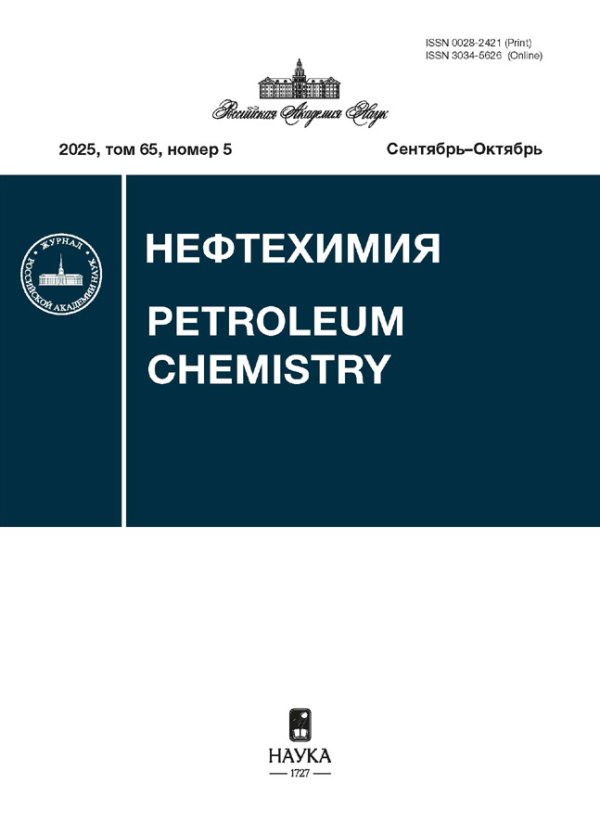Никельфосфидный катализатор на основе мезопористого наносферического полимера в процессе гидрирования гваякола и фурфурола
- Authors: Шакиров И.И.1, Бороноев М.П.1, Ролдугина Е.А.1, Кардашева Ю.С.1, Кардашев С.В.1
-
Affiliations:
- Московский государственный университет имени М. В. Ломоносова
- Issue: Vol 65, No 2 (2025)
- Pages: 161-170
- Section: Articles
- URL: https://rjsvd.com/0028-2421/article/view/686760
- DOI: https://doi.org/10.31857/S0028242125020093
- EDN: https://elibrary.ru/KMLBKH
- ID: 686760
Cite item
Abstract
Получен нанесенный никельфосфидный катализатор in situ в условиях синтеза мезопористого резорцинформальдегидного полимера. Катализатор испытан в гидрировании гваякола и фурфурола в толуоле при давлении водорода 4 МПа. Исследованы характеристики гидрирования фурфурола в зависимости от давления водорода, массы загруженного катализатора, температуры и продолжительности процесса. Оценена активность полученного никельфосфидного катализатора в гидрировании смеси гваякола и фурфурола в толуоле.
Full Text
About the authors
Искандер Ильгизович Шакиров
Московский государственный университет имени М. В. Ломоносова
Author for correspondence.
Email: sammy-power96@yandex.ru
ORCID iD: 0000-0003-2029-693X
химический факультет
Russian Federation, Москва, 119991Максим Павлович Бороноев
Московский государственный университет имени М. В. Ломоносова
Email: sammy-power96@yandex.ru
ORCID iD: 0000-0001-6129-598X
химический факультет; к. х. н.
Russian Federation, Москва, 119991Екатерина Алексеевна Ролдугина
Московский государственный университет имени М. В. Ломоносова
Email: sammy-power96@yandex.ru
ORCID iD: 0000-0002-9194-1097
химический факультет; к. х. н.
Russian Federation, Москва, 119991Юлия Сергеевна Кардашева
Московский государственный университет имени М. В. Ломоносова
Email: sammy-power96@yandex.ru
ORCID iD: 0000-0002-6580-1082
химический факультет; к. х. н.
Russian Federation, Москва, 119991Сергей Викторович Кардашев
Московский государственный университет имени М. В. Ломоносова
Email: sammy-power96@yandex.ru
ORCID iD: 0000-0003-1818-7697
химический факультет; к. х. н.
Russian Federation, Москва, 119991References
- Lu Q., Li W.-Z., Zhu X.-F. Overview of fuel properties of biomass fast pyrolysis oils // Energy Convers. Manage. 2009. V. 50, № 5. P. 1376–1383. https://doi.org/10.1016/j.enconman.2009.01.001
- Jin W., Pastor-Pérez L., Shen D., Sepúlveda-Escribano A., Gu S., Ramirez Reina T. Catalytic upgrading of biomass model compounds: novel approaches and lessons learnt from traditional hydrodeoxygenation — a review // ChemCatChem. 2019. V. 11, № 3. P. 924–960. https://doi.org/10.1002/cctc.201801722
- Ouedraogo A.S., Bhoi P.R. Recent progress of metals supported catalysts for hydrodeoxygenation of biomass derived pyrolysis oil // J. Clean. Prod. 2020. V. 253. ID119957. https://doi.org/10.1016/j.jclepro.2020.119957
- Qu L., Jiang X., Zhang Z., Zhang X.-G., Song G.-Y., Wang H.-L., Yuan Y.-P., Chang Y.-L. A review of hydrodeoxygenation of bio-oil: model compounds, catalysts, and equipment // Green Chem. 2021. V. 23, № 23. P. 9348–9376. https://doi.org/10.1039/D1GC03183J
- Gollakota A.R.K., Shu C.-M., Sarangi P.K., Shadangi K.P., Rakshit S., Kennedy J.F., Gupta V.K., Sharma M. Catalytic hydrodeoxygenation of bio-oil and model compounds — choice of catalysts, and mechanisms // Renew. Sustain. Energy Rev. 2023. V. 187. ID113700. https://doi.org/10.1016/j.rser.2023.113700
- Kim S., Kwon E.E., Kim Y.T., Jung S., Kim H.J., Huber G.W., Lee J. Recent advances in hydrodeoxygenation of biomass-derived oxygenates over heterogeneous catalysts // Green Chem. 2019. V. 21, № 14. P. 3715–3743. https://doi.org/10.1039/C9GC01210A
- Yao G., Wu G., Dai W., Guan N., Li L. Hydrodeoxygenation of lignin-derived phenolic compounds over bi-functional Ru/H-Beta under mild conditions // Fuel. 2015. V. 150. P. 175–183. https://doi.org/10.1016/j.fuel.2015.02.035
- Golubeva M.A., Maximov A.L. Transition metal compounds in the hydrodeoxygenation of biomass derivatives // Renew. Sustain. Energy Rev. 2025. V. 210. ID115153. https://doi.org/10.1016/j.rser.2024.115153
- Бороноев М.П., Шакиров И.И., Ролдугина Е.А., Кардашева Ю.С., Кардашев С.В., Максимов А.Л., Караханов Э.А. Гидрирование гваякола на наноразмерных рутениевых нанесенных катализаторах: влияние размера частиц носителя и присутствия оксигенатов бионефти// Журн. прикл. химии. 2022. Т. 95, № 10. С. 1263–1272. http://doi.org/10.31857/S004446182210005X [Boronoev M.P., Shakirov I.I., Roldugina E.A., Kardasheva Y.S., Kardashev S.V., Maksimov A.L., Karakhanov E.A. Hydrogenation of guaiacol on nanoscale supported ruthenium catalysts: influence of support particle size and the presence of bio-oil oxygenates // Russ. J. Appl. Chem. 2022. V. 95, № 10. P. 1555–1563. https://doi.org/10.1134/S1070427222100068]
- Liang C., Li Z., Dai S. Mesoporous carbon materials: synthesis and modification // Angew. Chem. Int. Ed. 2008. V. 47, № 20. P. 3696–3717. https://doi.org/10.1002/anie.200702046
- Wei J., Liang Y., Zhang X., Simon G.P., Zhao D., Zhang J., Jiang S., Wang H. Controllable synthesis of mesoporous carbon nanospheres and Fe–N/carbon nanospheres as efficient oxygen reduction electrocatalysts // Nanoscale. 2015. V. 7, № 14. P. 6247–6254. https://doi.org/10.1039/C5NR00331H
- Peroni M., Lee I., Huang X., Baráth E., Gutiérrez O.Y., Lercher J.A. Deoxygenation of palmitic acid on unsupported transition-metal phosphides // ACS Catal. 2017. V. 7, № 9. P. 6331–6341. https://doi.org/10.1021/acscatal.7b01294
- Golubeva M.A., Maximov A.L. Hydroprocessing of furfural over in situ generated nickel phosphide based catalysts in different solvents // Appl. Catal. A: Gen. 2020. V. 608. ID117890. https://doi.org/10.1016/j.apcata.2020.117890
- Wu S.-K., Lai P.-C., Lin Y.-C. Atmospheric hydrodeoxygenation of guaiacol over nickel phosphide catalysts: effect of phosphorus composition // Catal. Lett. 2014. V. 144, № 5. P. 878–889. https://doi.org/10.1007/s10562-014-1231-7
- Cecilia J.A., Infantes-Molina A., Rodríguez-Castellón E., Jiménez-López A. A novel method for preparing an active nickel phosphide catalyst for HDS of dibenzothiophene // J. Catal. 2009. V. 263, № 1. P. 4–15. https://doi.org/10.1016/j.jcat.2009.02.013
- Bui P., Cecilia J.A., Oyama S.T., Takagaki A., Infantes-Molina A., Zhao H., Li D., Rodríguez-Castellón E., Jiménez López A. Studies of the synthesis of transition metal phosphides and their activity in the hydrodeoxygenation of a biofuel model compound // J. Catal. 2012. V. 294. P. 184–198. https://doi.org/10.1016/j.jcat.2012.07.021
- Wang R., Smith K.J. The effect of preparation conditions on the properties of high-surface area Ni2P catalysts // Appl. Catal. A: Gen. 2010. V. 380, № 1‒2. P. 149–164. https://doi.org/10.1016/j.apcata.2010.03.055
- Dai X., Song H., Yan Z., Li F., Chen Y., Wang X., Yuan D., Zhang J., Wang Y. Effect of preparation temperature on the structures and hydrodeoxygenation performance of /C catalysts prepared by decomposition of hypophosphites // New J. Chem. 2018. V. 42, № 24. P. 19917–19923. https://doi.org/10.1039/C8NJ04628J
- d’Aquino A. I., Danforth S.J., Clinkingbeard T.R., Ilic B., Pullan L., Reynolds M.A., Murray B.D., Bussell M.E. Highly-active nickel phosphide hydrotreating catalysts prepared in situ using nickel hypophosphite precursors // J. Catal. 2016. V. 335. P. 204–214. https://doi.org/10.1016/j.jcat.2015.12.006
- Li Y., Fu J., Chen B. Highly selective hydrodeoxygenation of anisole, phenol and guaiacol to benzene over nickel phosphide // RSC Adv. 2017. V. 7, № 25. P. 15272–15277. https://doi.org/10.1039/C7RA00989E
- Gonçalves V.O.O., de Souza P.M., Cabioc’h T., da Silva V.T., Noronha F.B., Richard F. Hydrodeoxygenation of m-cresol over nickel and nickel phosphide based catalysts. Influence of the nature of the active phase and the support // Appl. Catal. B: Environ. 2017. V. 219. P. 619–628. https://doi.org/10.1016/j.apcatb.2017.07.042
- Шакиров И.И., Бороноев М.П., Кардашев С.В., Путилин Ф.Н., Караханов Э.А. Селективное гидрирование фенола с использованием нанесенного на мезопористый наносферический полимер Ni2P-катализатора // Наногетерогенный катализ. 2021. Т. 6, № 2. С. 92–99. https://doi.org/10.56304/S2414215821020076 [Shakirov I.I., Boronoev M.P., Kardashev S.V., Putilin F.N., Karakhanov E.A. Selective hydrogenation of phenol using a Ni2P catalyst supported on mesoporous polymeric nanospheres // Petrol. Chem. 2021. V. 61, № 10. P. 1111–1117. https://doi.org/10.1134/S0965544121100042]
Supplementary files



















